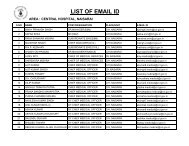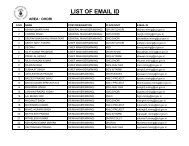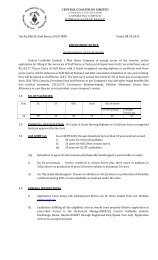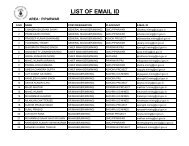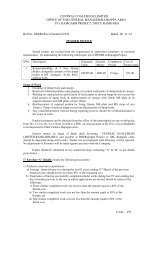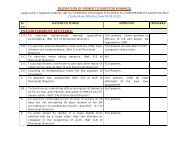Vigilance Compedium - CCL
Vigilance Compedium - CCL
Vigilance Compedium - CCL
Create successful ePaper yourself
Turn your PDF publications into a flip-book with our unique Google optimized e-Paper software.
2.3.3 Security in Data storage and communication.<br />
Issues<br />
Encryption for<br />
data storage<br />
Data transfer<br />
security<br />
Access control.<br />
Best Practices to achieve security considerations<br />
Sensitive data should be encrypted or hashed in the database and file<br />
system. The application should differentiate between data that is<br />
sensitive to disclosure and must be encrypted, data that is sensitive only<br />
to tampering and for which a keyed hash value (HMAC) must be<br />
generated, and data that can be irreversibly transformed (hashed)<br />
without loss of functionality (such as passwords). The application<br />
should store keys used for decryption separately from the encrypted<br />
data.<br />
Examples of widely accepted strong ciphers are 3DES, AES, RSA, RC4<br />
and Blowfish. Use 128-bit keys (1024 bits for RSA) at a minimum.<br />
Sensitive data should be encrypted prior to transmission to other<br />
components. Verify that intermediate components that handle the data<br />
in clear-text form, prior to transmission or subsequent to receipt, do not<br />
present an undue threat to the data. The application should take<br />
advantage of authentication features available within the transport<br />
security mechanism.<br />
Specially, encryption methodology like SSL must be deployed while<br />
communicating with the payment gateway over public network.<br />
Applications should enforce an authorization mechanism that provides<br />
access to sensitive data and functionality only to suitably permitted<br />
users or clients.<br />
Role-based access controls should be enforced at the database level as<br />
well as at the application interface. This will protect the database in the<br />
event that the client application is exploited.<br />
Authorization checks should require prior successful authentication to<br />
have occurred.<br />
All attempts to obtain access, without proper authorization should be<br />
logged.<br />
Conduct regular testing of key applications that process sensitive data<br />
and of the interfaces available to users from the Internet Include both<br />
“black box” informed” testing against the application. Determine if<br />
users can gain access to data from other accounts.<br />
3.0 Some of the other good practices for implementers of e-procurements to achieve<br />
security considerations are as follows:-<br />
3.1 Common unified platform for all department.<br />
A single platform to be used by all departments across a State / Department/<br />
Organizations reduces the threat to security of data. With a centralized implementation,<br />
where in the procurement data is preferably hosted and maintained by the State /






